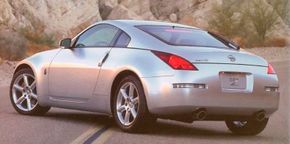350Z Power and Sound
The Nissan 350Z power and sound befit a true sports car.
Continuously Variable Valve Timing Control System (CVTCS) aided drivability and maximized low- and midrange torque. It also reduced valve overlap at idle for smoothness, and at cruising speeds it was configured to enhance fuel economy.
Advertisement
Furthermore, CVTCS eliminated the need for an exhaust gas recirculation valve because the increased valve overlap it allowed permitted sufficient exhaust-gas to re-enter the combustion chambers and reduce combustion temperatures, thereby reducing oxides of nitrogen.
To accomplish its tasks, CVTCS incorporated a 32-bit microprocessor for fast response. It analyzed a number of parameters including engine speed, engine load, throttle position and road speed.
The processor directed a duty-cycle electric solenoid atop each cam cover to vary the oil pressure to the intake-cam timing-chain sprockets. As oil pressure changed, it moved the position of vanes inside the sprockets, rotating them relative to the camshafts and thus varying the intake-valve tinning.
The result of all these efforts was a potent, tractable powerplant that was well-suited to a car intended to be both sporty and refined. In the inaugural 2003 350Z, the 3498-cubic-centimeter dual-overhead-cam, 24-valve V-6 produced 287 horsepower at 6200 rpm and 274 pound-feet of torque at 4800 rpm.
That was up substantially from the VQ engine's applications in the Pathfinder and QX4 SUVs. Though peak power occurred at 6200 rpm, maximum torque was moved a bit higher in the rev range. Redline was 6600 rpm, signing off earlier than the 300ZX's 7000-rpm limit.
The Sound of Z Power
From the very start, a core goal of engineers working on the 350Z engine was to deliver a powerful sound from the intake and exhaust, without high-pitched, "tinny" mechanical sounds or the low-frequency booming or rumbling that can grow tiresome on long trips.
From driving Italian exotic cars, such as the Maserati 3200GT and the Ferrari 360 Modena, F355 and F40, Nissan studied the "emotional" aspects of intake and exhaust sounds. Benchmarks for the 350Z's induction sound were the BMW M Coupe, Porsche Boxster, and Nissan Skyline GT-R.
The exhaust sound was maximized at low engine speed (1000-3500 rpm), but quiet at normal cruising. And intake sound maximized at high engine speed (3500-6000 rpm) -- especially at wide throttle openings -- but toned down during cruising.
Nissan used straight intake ducts and removed the 0.5 harmonic to give a "clear" intake sound. A variable intake manifold was not used in the 350Z.
The 350Z's exhaust had reduced back pressure and was freer flowing than in any other Nissan. Its equal-length exhaust-manifold branches fed a large-diameter single pipe, which fluted to dual outlets aft of the rear axle. A complete dual system was discarded due to cost, weight and aerodynamics.
For more on Nissan Zs and other great sports cars, check out:
- Nissan Z
- Sports Cars
- Porsche Cars
- Ferrari
